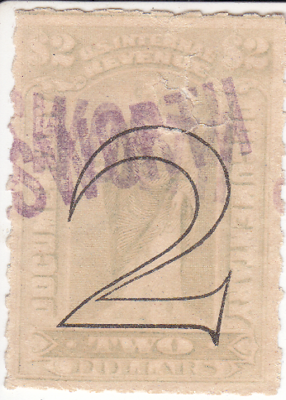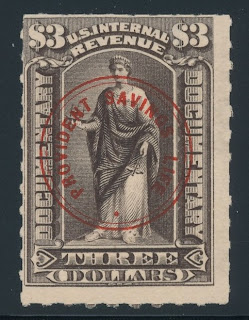W. S. Alley
Dave Thompson scan
Here is another Dave Thompson cancel, this time associated with a remarkable and publicly told tragedy. Thanks to Dave for digging up this article from The New York Times:
The New York Times, August 7, 1907:
W. S. ALLEY A SUICIDE; LOST ALL IN STOCKS
Noted Broker and Clubman Shoots Himself in Larchmont Yacht Club.
HIS LOSSES PREYED ON HIM
But He Maintained Outwardly His Cheery Disposition to the Last -- One of the Club's Founders and a Wit.
The "Rocking Chair Fleet" on the plaza of the Larchmont Yacht Club, rocked away last night without its principal founder and chief member, its veritable Pooh Bah, William S. Alley.
Life at Larchmont, where Mr. Alley lived year around with his family, was placid and sweet. His house was within the toss of a stone from the Sound, where, in his palmy days, his champion sloop, The Schemer, showed her neat lines to him from his own piazza of a morning. But life in Wall Street, where Mr. Alley strove to increase his fortune, proved a tempest he could not weather. His father before him, George B. Alley, had accumulated a large fortune, and had died after a successful life, leaving much wealth to his family. But "Bill" alley, as his fellow-yachtsmen and the members of the "Rocking Chair" coterie knew him, hit the market at the wrong angle every time.
Yesterday morning Wall Street heard that "Bill" Alley was dead.
"How?" was asked by broker after broker, for all of them knew that he had been compelled to sacrifice his seat on the exchange, and that not only every dollar of his money was gone, but that he was also burdened with debt.
"Blew out his brains," was the reply of those who had come to town from Larchmont. "In the club last night. He slipped away from the crowd and finished it in a quiet corner."
Mr. Alley left his home, a short distance from the club, on Monday afternoon and spent the cool, early evening chatting with friends in the club and on the piazzas. He appeared in good humor, and a number of his friends commented on his courage in standing up under the disasters he had met on the Street. Then he excused himself, retired to a distant corner where no one could interfere with him, pulled a revolver from his pocket, and shot himself through the right temple. He was still living when the club attendants and his friends reached him. They hurried him to the New Rochelle Hospital, but he died there five minutes after he had been put to bed.
Although he appeared to be jovial at all times, some of his friends say that when he was suspended from the Exchange, because of a judgment obtained against him when his luck seemed hardest, he felt this keenly, and protested that an injustice had been done to him. The judgment was settled and he was reinstated. But another judgment was filed against him, and he was crowded close to the wall. He sold his seat and filed a petition in bankruptcy. He gave the proceeds of the sale of his seat to his creditors, whose claims amounted to $191,000, and then retired to an obscure desk in the office of a brokerage firm in Exchange Place.
Mr. Alley was one of four yachtmen who founded the Larchmont Yacht Club. He drew up the by-laws and the constitution, and was the club's moving spirit in the early days. His good nature, his wit, and his money made him a great favorite with the rich men who became members. As long as fortune smiled on him he was the club's bright particular star. Even when he disappeared from Wall Street to that obscure Exchange Place desk, where he dealt in outside securities, and even when his handsome home in Larchmont began to show the need of paint and was minus a butler, he was still welcome at the club.
Yesterday, when a Times reporter called at his home to inquire about the manner of his death, the place seemed a typification of the end of its owner. The lack of cash resources showed pathetically. The houses adjoining were spick and span, with velvety lawns and well trimmed hedges and well kept paths. The once bright abiding place of the popular yachtman "Bill" Alley showed the unmistakable sign of genteel poverty. The father of The Larchmont Yacht Club, for he was credited for having been its founder, couldn't stand that sort of thing. His two young sons, bright little chaps, were playing ball on the untrimmed lawn, not realizing their loss.
The "Rocking Chair" coterie tell many good stories about their old chief chairman, for every member was, perforce, a chairman. One of them shows how practical was his wit. On ladies' day the club invariably suffered from the souvenir-appropriating craze. Bric-a-brac and silver invariably disappeared on that day. Finally the visitors began to take away small pictures with them, and the loss of one little masterpiece made the matter one for serious consideration. It was left for Mr. Alley to put an end to this evil. He did. He inserted in a New York newspaper a notice that the Larchmont Yacht Club's members knew the person who had stolen the painting, and that unless it was returned, along with other things taken on that particular day, the names would be published. The picture was returned immediately, together with a number of more or less valuable articles that had been carried away by souvenir the hunters.
Mr. Alley became a member of the Stock Exhange in 1878. He was founder of the firm Alley, Conger & Co., which was afterward dissolved, and then became the senior member of the firm of W. S. Alley & Co. he is survived by his widow and two sons. He was 55 years old.
A report was current yesterday that Mr. Alley killed himself so that his widow could collect the $10,000 insurance gratuity which the Stock Exchange provides for its members. Although Mr. Alley had sold his seat on the Exchange, the transfer of the seat had not been made. The change in its possession will occurr tomorrow. The funeral will be held probably on Friday, the Rev. Richard Cobden, Chaplain of the Larchmont Yacht Club, officiating.
*****












































